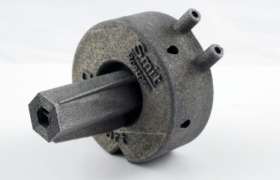Tungsten powder, in its pure form and as a composite, is now available for additive manufacturing, using Selective Laser Melting (SLM) and as of late binder jetting technologies.
Tungsten is also known as Wolfram, is a rare metal famous for having the highest melting point of all elements. Tungsten or Wolfram is mostly known to the general public as the filament used in light bulbs, but it has many other lesser-known, industrial and medical applications, when applied as a composite or in its pure form.
The name is derived from the Swedish word for the metal meaning ‘heavy stone’. In its pure form, the material is very soft or brittle and is almost always combined with other elements to form a composite to achieve the hardness tungsten alloys are known for.
Tungsten carbide is the most famous of these composites. It is a combination of tungsten and carbon. The result is a ceramic composite.
Other combinations involve steel, known as high-speed steel, cobalt, copper, bronze, chromium, iron, or nickel. Tungsten is also a part of a nickel-molybdenum-chromium superalloy known as Hastelloy. In all instances the composite results in exceptionally hard metal.
Pure tungsten does not have the hardness of a composite, but its excellent heat resistance and radiation shielding properties are useful in the nuclear and medical fields.
What is tungsten and tungsten carbide used for?
As mentioned in the introduction paragraph, tungsten has a high melting temperature. It has the highest melting temperature of all metals at 3,422 °C . This in combination with hardness makes it an interesting material for applications that need hardness and heat resistance. Tungsten composites are used in industries ranging from aerospace, automotive, nuclear, defense, medical to leisure.
Examples of applications are: rocket engine nozzles, weapon heads (to penetrate hard surfaces), turbine blades for aircraft (heat resistant), and smaller tools such as saw blades, drill bits, bearings, pistons and welding equipment.
The medical industry uses pure tungsten for MRI scanning, collimators, and radiation shielding.
3D printing with tungsten
The hardness of tungsten carbide and other such composites also has its drawback. Its hardness makes it a difficult material to create models using traditional manufacturing techniques like CNC and tooling. Additive manufacturing by its nature could prove to be a solution to this problem.
Additive Manufacturing also offers the ability to manufacture complex parts without the need for tooling. Tungsten composite models can be produced more cost-effectively and faster using AM.
Parts made by AM can be highly detailed and thin. Details as small as 100 μm with a positional accuracy down to 25 μm can be achieved.
There are currently two AM technologies available for pure tungsten and tungsten composites:
Selective Laser Melting
Selective Laser Melting (SLM) or Direct Metal Laser Sintering (DMLS) is an additive manufacturing method whereby a laser melts and fuses together metal powder to form 3-dimensional objects.
Initially, the high melting point posed some technical hurdles to apply the material to 3D printing, but these have been overcome.
Pure tungsten powder is bound using nickel-copper or nickel-iron
Binder jetting
Leading 3D metal print machine manufacturer ExOne is working with a material manufacturer to develop a copper-tungsten composite, that can be used in ExOne’s binder jetting machines.
The composite will have high heat resistance, high electrical and thermal conductivity, and low thermal expansion. Binder Jetting has the advantage over SLM that it is more economical. There are currently different powders available, at different stages of qualification.
Also available for binder jetting is a bronze-tungsten alloy.
Properties of tungsten:
- High melting point, melting at 3422 °C, higher than that of platinum.
- High density (19,25g/cm3), comparable to gold
- It has the highest tensile strength at temperatures over 1650°C
- Excellent corrosion resistance
- Excellent X-ray and Gamma-ray absorption/shielding
- Resistance to most acids
- Biocompatible / non-toxic
